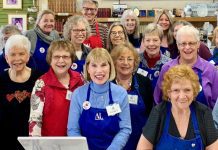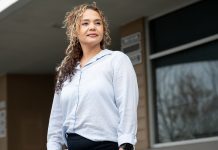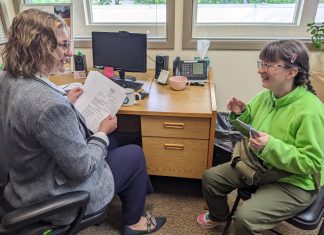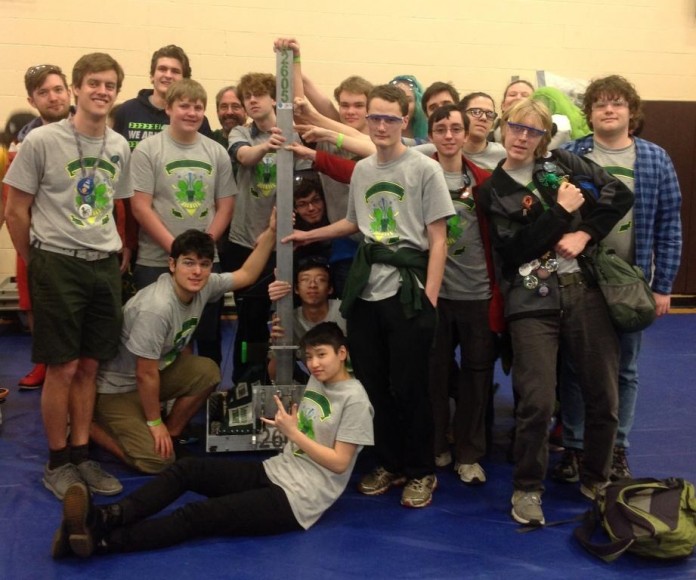
By Lorraine Wilde
![]() Bellingham School District’s high school Robotics Club, held at Sehome High School, is learning technical, communication, and interpersonal skills while competing in the FIRST Robotics Competition (FRC). FIRST, For Inspiration and Recognition of Science and Technology, is a national non-profit organization committed to mentoring kindergarten through twelfth grade students to develop science, engineering, and technology skills. Sehome teacher, Kevin Criez, has taught at Sehome since 1993 and steered the team since its first competition in 2008. The District has recently been putting more emphasis on STEAM (Science, Technology, Engineering, Arts, and Mathematics) and Robotics is a shining example. “This type of applied education provides a whole lot more than standardized tests and typical learning from books,” notes Criez.
Bellingham School District’s high school Robotics Club, held at Sehome High School, is learning technical, communication, and interpersonal skills while competing in the FIRST Robotics Competition (FRC). FIRST, For Inspiration and Recognition of Science and Technology, is a national non-profit organization committed to mentoring kindergarten through twelfth grade students to develop science, engineering, and technology skills. Sehome teacher, Kevin Criez, has taught at Sehome since 1993 and steered the team since its first competition in 2008. The District has recently been putting more emphasis on STEAM (Science, Technology, Engineering, Arts, and Mathematics) and Robotics is a shining example. “This type of applied education provides a whole lot more than standardized tests and typical learning from books,” notes Criez.
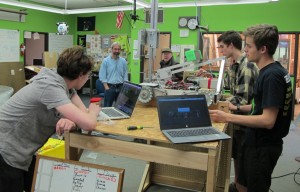
The Club’s FRC team, affectionately known as the Sehome Seamonsters, is open to District students grades 9 through 12, but consists of primarily Sehome High students. “It costs a minimum of about $12,000 to build a robot and compete, not to mention the space, tools, and machinery required, so it makes sense to have one team for the whole District,” clarifies Criez.
During our interview, students were working frantically in the final two hours of their six-week time period allotted by FRC to design and build a robot capable of performing the Recycle Rush, a specific set of tasks that includes moving and stacking at least two different types of recycling containers. “If the team performs well at two double-elimination qualifying competitions, they will be invited to the Pacific Northwest Regional Competition held in Spokane,” explains Criez. “Roughly the top third of teams move forward to regionals and then about 14 teams from each region head to the National Championships.”
To be competitive, a team needs leadership and a breadth of practical skill. The Seamonsters are led by Team Captain, Zachary Larson, and a group of seniors who have competed for each of the past four years. “Most people don’t get to build leadership skills until they’re well into the work force. We’re getting that now. We organize people, deal with conflict, roll with failure, all while building things together,” notes Larson. “This experience has given me more people and communication skills, not just engineering.”
The team’s lead programmer, Liam Taylor, agrees. “I’ve learned quite a bit about project management and what is reasonable to accomplish in six weeks,” chuckles Taylor. “For this competition, since the summer, I’ve taught myself advanced computer programming skills, including the program C++. As of today, I’ve written 47,000 lines of code for this robot.”
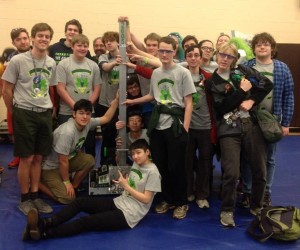
Robotics may run in some families. “This team has not been without a Mallory or Loeppky in years,” laughs Criez. “Next year will be very different.” Criez is referring to home schooled/Running Start student, Cannon Mallory, the team go-to for CNC, a computer-controlled metal fabrication machine, and George Loeppky, who is a lead fabricator and team robot driver. Both have older brothers who were on the team in previous years and Loeppky’s father, David, is an electrical engineer who mentors the team. Mallory’s older brothers, Ryan and AJ, were also home school/Running Start students who took robotics courses at Sehome with George’s older brother, Mitchell. Now, all three attend the University of Washington’s (UW) Engineering program and work on the EcoCar Challenge.
Young women are underrepresented in the Seamonsters lineup. “Of the eighteen students heading to the competition, three are young women. But we expect that to shift in the future,” observes Criez. “Kulshan Middle School hosts a new district-wide all-girls robotics club with help from an ALCOA grant. Fifty girls from every middle school showed up for the first meeting. Our Seamonster women are mentoring these middle schoolers so they’ll be able to hold their own when they get here.”
At FRC, judges inspect and evaluate each robot for merit in engineering, design, programming, and presentation in addition to their performance in the recycle rush game. But a team never competes alone. “These kids have to communicate with other teams in order to do well,” explains team mentor and Bellingham design consultant, Dr. Jeff Kerr. “You get more points through communicating strategy and working together with other teams. It is good practice working with people they don’t know and presenting the features of their robot to others,” notes Kerr. “The teams that do the best tend to have solid organization and communication skills.”
Mentors like Kerr and David Loeppky offer expertise Criez cannot provide. Students are learning from several other community members as well who work real jobs in industry, manufacturing, and consulting. “We’d welcome more help from programmers and business people,” beams Criez.
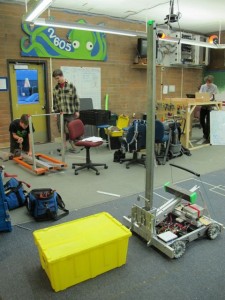
The FRC has also impacted the District’s middle and high school curricula. Sehome offers students applied physics, robotics engineering, and fabrication classes. “We’ve adapted to the changing times and have added 3-D printing, laser cutting, and electronics. These are skills and equipment our students will see and need in the real world,” explains Criez. “We also have robotics clubs at all four middle schools and FRC has attracted industry support to our schools.” The team fundraises each year, earning a Boeing sponsorship this year and NASA support last year.
“They’re not just learning robotics, they’re learning business, interpersonal and public communication skills, marketing, video production, sales, and graphic design,” lists Criez. “That variety from a single program is not typical.” This range of knowledge has given students both ability and future options.
“Robotics has helped me think methodically and problem-solve under pressure as part of a team,” notes Mallory. He and most of the other seniors are waiting to hear about their applications to the UW Engineering program and at least one other out-of-state university. Still others on the team will enter local industry or technical programs at Bellingham Technical College after graduation. “I’m planning to job-shadow at multiple industries and engineering firms when FRC is over,” reveals Larson. “I want to know what real engineers do and then decide what type I’d like to do.”
The multi-talented Seamonsters are positioned to do well this year at FRC. They placed third at their first qualifying competition in Auburn in late February and will head to their second 3-day competition in Mt. Vernon on March 13. Their community of supportive teachers, parents, and mentors will be in the wings, cheering for their student’s hard work.

























